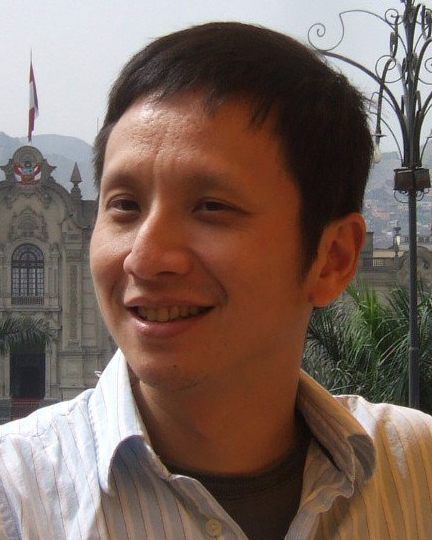
杨天明 博导 中国科学院神经科学研究所
电子邮件: tyang@ion.ac.cn
通信地址: 上海市岳阳路320号系统神经科学楼302室
邮政编码:
研究领域
本研究组长期进行与高等认知与抉择相关的各个脑区的功能及其相互作用的神经机制方面的研究。 其研究以猕猴作为动物模型,运用神经电生理技术记录大脑活动,研究大脑神经元在进行抉择的过程中的神经计算的原理。这些研究包含了脑的许多功能区,如视皮层、前额叶、颞叶、枕叶、海马等等,为解释抉择的神经机制,了解大脑各脑区之间的相互联结和协作做出了贡献。
1、大脑前额叶和侧顶叶在抉择,尤其是基于模糊和不完全的信息的抉择中所起到的作用
数学上,模糊的信息可以用概率来量化。大脑是否也是运用概率原理来进行抉择一直是抉择领域的一个研究热点。本研究组采用了适用于猕猴这一动物模型的概率推理的行为范式。在这个范式中,猕猴通过学习一些图形来进行抉择。这些图形可以告知猕猴如何进行抉择,但是它们都只提供不确定的概率性的信息。我们试图采用神经电生理的技术在单个神经元活动的水平上发现在这个抉择过程中前额叶各个脑区以及侧顶叶之间的功能连接和神经计算环路。
2、人的抉择行为的研究
人的抉择与价值和奖赏环路密切相关。在针对人脑中的奖赏回路的研究中,发现人脑处理价值信息的神经机制与非人灵长类动物有许多相似之处。但是人脑的复杂性也造就了其特殊性。本研究组针对人脑中的VMPFC、 眶额叶、基底叶等脑区在抉择中的活动的分析,力图发现它们是如何相互协作完成基于价值的抉择和学习的任务。另外,本研究组还与一些医院进行合作,研究与抉择相关的精神疾病(如强迫症、抑郁症、厌食症等)的病人的抉择行为。这些研究针对人脑的奖赏回路,旨在发现正常人与病人之间大脑结构的异同,为这些疾病的治疗指明方向。
3、计算神经网络理论方面的研究
通过建立人工神经网络来模拟大脑神经元的活动,构建了一种随机神经网络,可以很好的模拟大脑前额叶工作记忆相关的神经元的特异性和时间上的动态反应。这些工作在理论上有助于理解实验中所获得的神经细胞活性的数据,帮助我们更好地理解大脑的工作方式,并为未来的实验工作提供新的方向。
招生信息
招生专业
招生方向
代表性论文
Lin Z*, Nie C*, Zhang Y*, Chen Y, Yang T (2020) Evidence accumulation for value computation in the prefrontal cortex during decision making. Proc Natl Acad Sci. 117(48): 30728-30737
Zhang Z, Cheng H, Yang T (2020) A recurrent neural network model for flexible and adaptive decision making based on sequence learning. PLoS Comput Biol. 16(11): e1008342
Chen X, Yang T (2020) A neural network model of basal ganglia’s decision-making circuitry. Cogn Neurodyn. https://doi.org/10.1007/s11571-020-09609-2
Liu D, Deng J, Zhang Z, Zhang Z, Sun Y, Yang T, Yao H (2020) Orbitofrontal control of visual cortex gain promotes visual associative learning. Nat. Commun. 11, 1–14.
Al Roumi F, Dotan D, Yang T, Wang L, Dehaene S. (2019) Acquisition and processing of an artificial mini-language combining semantic and syntactic elements. Cognition 185: 49-61.
Xie Y, Nie C, Yang T (2018) Covert shift of attention modulates the value encoding in the orbitofrontal cortex. eLife 7:e31507.
Zhang Z*, Cheng Z*, Lin Z, Nie C, Yang T (2018) A neural network model for the orbitofrontal cortex and task space acquisition during reinforcement learning. PLoS Comput Biol 14:e1005925 *Co-first authors.
Zhang C*, Chen Y*, Tian S, Wang T, Xie Y, Jin H, Lin G, Gong H, Zeljic K, Sun B, Yang T#, Zhan S# (2017) Effects of anterior capsulotomy on decision making in patients with refractory Obsessive–Compulsive Disorder. Front Psychol 8:1814 *Co-first authors #Co-corresponding authors.
Shadlen MN, Kiani R, Newsome WT, Gold JI, Wolpert DM, Zylberberg A, Ditterich J, de Lafuente V, Yang T, Roitman J (2016) Comment on “Single-trial spike trains in parietal cortex reveal discrete steps during decision-making”. Science 351:1406.
Cheng Z, Deng Z, Hu X, Zhang B, Yang T (2015) Efficient reinforcement learning of a reservoir network model of parametric working memory achieved with a cluster population winner-take-all readout mechanism. J Neurophysiol 114:3296–3305.
Kira S*, Yang T*, Shadlen MN (2015) A neural implementation of Wald’s sequential probability ratio test. Neuron 85:861–873. *Co-first authors.
Wheeler ME, Woo SG, Ansel T, Tremel JJ, Collier AL, Velanova K, Ploran EJ, Yang T (2015) The strength of gradually accruing probabilistic evidence modulates brain activity during a categorical decision. J Cogn Neurosci.
Rudebeck PH, Putnam PT, Daniels TE, Yang T, Mitz AR, Rhodes SE V, Murray EA (2014) A role for primate subgenual cingulate cortex in sustaining autonomic arousal. Proc Natl Acad Sci 111:5391–5396.
Yang T, Bavley RL, Fomalont K, Blomstrom KJ, Mitz AR, Turchi J, Rudebeck PH, Murray EA (2014) Contributions of the hippocampus and entorhinal cortex to rapid visuomotor learning in rhesus monkeys. Hippocampus 24:1102–1111.
Yang T, Shadlen MN (2007) Probabilistic reasoning by neurons. Nature 447:1075–1080.
Shadlen MN, Hanks TD, Churchland AK, Kiani R, Yang T (2006) The speed and accuracy of a simple perceptual decision: a mathematical primer. Bayesian brain Probabilistic approaches to neural coding:209–237.
Yang T, Maunsell JHR (2004) The effect of perceptual learning on neuronal responses in monkey visual area V4. J Neurosci 24:1617–1626.
Ghose GM, Yang T, Maunsell JHR (2002) Physiological correlates of perceptual learning in monkey V1 and V2. J Neurophysiol 87:1867–1888.
